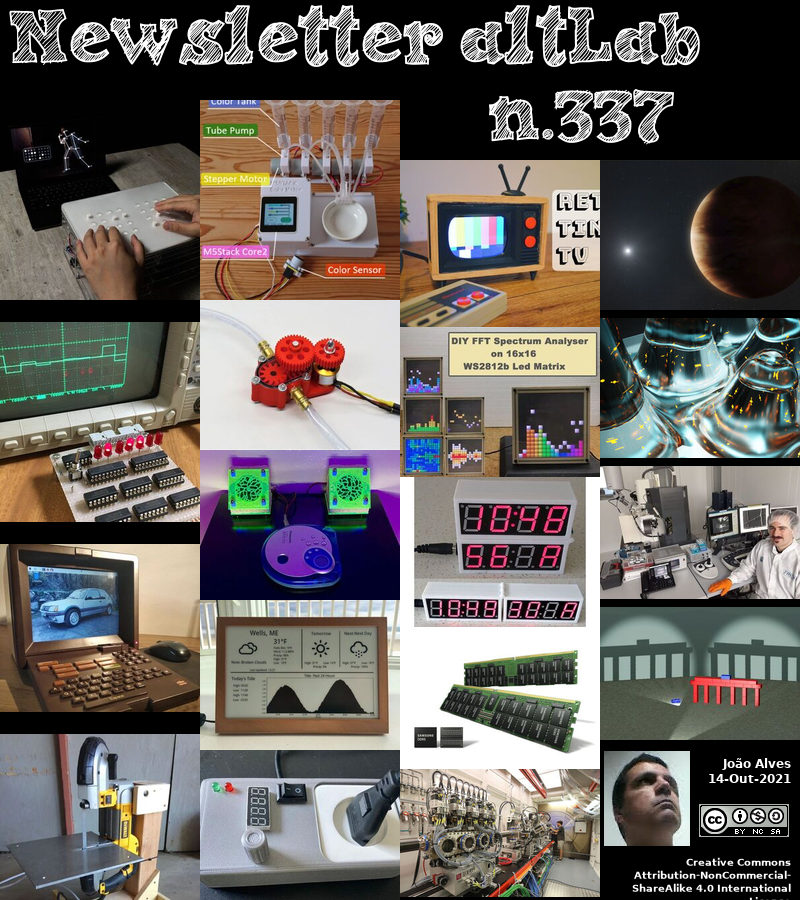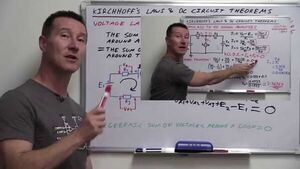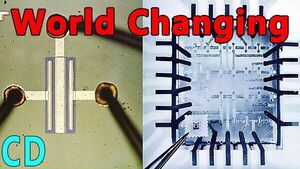2021-10-14 - Nº 337
Editorial
Esta é a Newsletter Nº 337 que se apresenta com o mesmo formato que as anteriores. Se gostar da Newsletter partilhe-a!
Todas as Newsletters encontram-se indexadas no link.
Esta Newsletter tem os seguintes tópicos:
Faz hoje anos que nascia, em 1788, o físico, astrónomo e explorador irlandês-inglês Edward Sabine. Ele estudou a forma da Terra e o seu campo magnético. Foi nomeado na Artilharia Real, e atingiu o posto de Major-General antes de se reformar em 1877. Como explorador, o astrónomo do partido, juntou-se à expedição de John Ross para encontrar a Passagem do Noroeste (1818). Também foi com Parry numa expedição ao Árctico (1819-20). Através de experiências utilizando um pêndulo em diferentes locais globais, ele determinou a forma da Terra (1821-3). Sabine também estudou o campo magnético da Terra, e a 6 de Abril de 1852 anunciou a ligação entre manchas solares e variações geomagnéticas irregulares.
Faz também hoje anos que nascia, em 1840, o físico alemão Friedrich Wilhelm Georg Kohlrausch. Ele investigou as propriedades dos electrólitos (substâncias que conduzem electricidade em soluções por transferência de iões) e contribuiu para a compreensão do seu comportamento. Algumas das realizações pioneiras de Kohlrausch incluem medições de condutividade em electrólitos, o seu trabalho na determinação de grandezas magnéticas e eléctricas básicas, e o aperfeiçoamento das tecnologias de medição associadas. Foi sob a sua direcção que a "Physikalisch-Technische Reichsanstalt" (o então Instituto Imperial Técnico Físico na Alemanha) criou numerosas normas e padrões de calibração que foram também utilizados internacionalmente fora da Alemanha.
Faz igualmente hoje anos que nascia, em 1857, o inventor norte-americano Elwood Haynes. Ele construiu um dos primeiros automóveis a gasolina de sucesso. Em 1886, quando o gás natural foi encontrado na sua cidade natal de Portland, Indiana, Haynes organizou uma empresa para o fornecer à cidade. Ele concebeu um método para desidratar o gás antes de este ser bombeado através das linhas. Também em 1886, inventou um pequeno termóstato de vapor utilizado no gás natural. Em 1893, comprou um motor a gasolina e concebeu uma "carruagem sem cavalos". Quando Haynes estava à procura de uma liga que fizesse um eléctrodo de vela durável, inventou a liga de stellite, cuja invenção ainda hoje contribui para a sociedade. Mais duro que o aço e resistente à corrosão, este metal desempenha agora um papel importante no fabrico de materiais aeronáuticos adequados para a exploração do espaço exterior.
Por fim, faz hoje anos que nascia, em 1908, o engenheiro electrotécnico norte-americano George Harold Brown. Ele foi pioneiro em rádio-térmica, que deu grandes contribuições para o desenvolvimento de antenas de rádio e televisão. Em 1936, Brown inventou a chamada antena de estilo "turnstyle" para a radiodifusão televisiva. Devido a isso, a Comissão Federal de Comunicações (FCC) adoptou um sistema de TV de 441 linhas. Em 1938, Brown desenvolveu o filtro de banda lateral vestigial para utilização na transmissão de televisão, duplicando a resolução horizontal das imagens de televisão em qualquer banda. Durante a II Guerra Mundial, com os investigadores da RCA, o grupo de George Brown utilizou o aquecimento por radiofrequência na desidratação a granel da penicilina na E.R. Squibb, uma "máquina de costura" para termoplásticos, e técnicas de rebitagem e soldadura mais consistentes.
Em 1947, Chuck Yeager, um piloto de caça da II Guerra Mundial, tornou-se o primeiro humano a voar mais rápido do que a velocidade do som, quebrando a barreira do som num avião Bell XS-1 movido a foguete sobre o Murac Dry Lake, Califórnia. Os quatro motores de foguetão deste minúsculo avião de investigação com nariz de agulha podiam engolir todo um fornecimento de combustível em 2-1/2 minutos. Para poupar combustível, o Bell XS-1 foi transportado para altitude por um B-29 e depois lançado, e Yeager disparou os seus foguetes. A 37.000 pés, o X-1 voou bem, mas começou a bater à medida que se aproximava da barreira do som. Quando um avião viaja à velocidade do som, as partículas de ar à frente são comprimidas numa "parede de ar espesso" invisível.
Nesta semana que passou foi lançado o Ubuntu 21.10. Denominado de "Impish Indri" esta versão que não é LTS traz como principais novidades o Desktop GNOME 40, o Kernel 5.13, PHP 8.0, GCC 11, Mesa 21.2 e utiliza a compressão Zstd para os pacotes Debian. Traz também suporte para a ultima versão dos drivers proprietários da NVIDIA com Wayland.
Na Newsletter desta semana apresentamos diversas noticias, artigos científicos, projetos de maker assim como alguns videos interessantes.
 João Alves ([email protected])
João Alves ([email protected])
O conteúdo da Newsletter encontra-se sob a licença  Creative Commons Attribution-NonCommercial-ShareAlike 4.0 International License.
Creative Commons Attribution-NonCommercial-ShareAlike 4.0 International License.
Novidades da Semana

Ubuntu 21.10 has landed
"Today, Canonical released Ubuntu 21.10 – the most productive environment for cloud-native developers and AI/ML innovators across the desktop, devices and cloud. “As open source becomes the new default, we aim to bring Ubuntu to all the corners of the enterprise and all the places developers want to innovate,” said Mark Shuttleworth. “From the biggest public clouds to the tiniest devices, from DGX servers to Windows WSL workstations, open source is the springboard for new ideas and Ubuntu makes that springboard safe, secure and consistent.” Made for Ubuntu developers wherever they are Ubuntu 21.10 brings the all-new PHP 8 and GCC 11 including full support for static analysis, greatly improving everyday developer security awareness in low-level programming. With Gnome 40 desktop users gain dynamic workspaces and touchpad gestures. The new Firefox snap, published by Mozilla, improves security and guarantees access to both the latest and the extended support release versions of the browser. The exact same versions of the browser are available on multiple different versions of Ubuntu, simplifying enterprise developer platform management." [...]
Outras Notícias
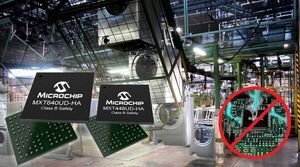
Capacitive Touchscreen Controller Family for the Home Appliance Market Dedicated to Work in Harsh and Noisy Environments
"Microchip extends its functional-safety-certified family of capacitive maXTouch® touchscreen controllers with the MXT448UD-HA and MXT640UD-HA to address screen sizes beyond 10 inches Networked and connected home appliances enable both users and manufacturers to communicate with them via the internet. For example, the user of a kitchen oven might look up a new recipe online or a manufacturer might perform remote diagnostics or over-the-air firmware updates. Displays and touch sensors are essential for enabling this functionality in modern appliances. Microchip Technology Inc. (Nasdaq: MCHP) is adding two new members to its family of IEC/UL 60730 Class B certified touchscreen controllers. The new MXT448UD-HA and MXT640UD-HA extend the Class B portfolio of devices beyond 10 inches, thus providing dedicated solutions for larger screen sizes as well as scalability to customers. In addition to Class B, these new devices are also compliant with the IEC61000-4-6 Class A specification for conducted noise immunity up to 10 Vrms (level three for industrial use)." [...]
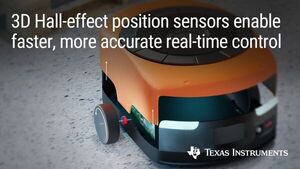
Industry's most accurate 3D Hall-effect position sensor provides speed and precision for faster real-time control
"TI sensor provides ultra-high precision at speeds as fast as 20 kSPS while using at least 70% less power Texas Instruments (TI) (Nasdaq: TXN) today introduced the industry’s most accurate 3D Hall-effect position sensor. With the TMAG5170, engineers can achieve uncalibrated ultra-high precision at speeds up to 20 kSPS for faster and more accurate real-time control in factory automation and motor-drive applications. The sensor also provides integrated functions and diagnostics to maximize design flexibility and system safety, while using at least 70% less power than comparable devices. The TMAG5170 is the first device in a new family of 3D Hall-effect position sensors that will meet a wide range of industrial needs – from ultra-high performance to general purpose. For more information, see www.ti.com/tmag5170-pr. "Smart factories have an increasing number of highly automated systems that must operate in a more integrated manufacturing flow while simultaneously collecting data to control processes," said Noman Akhtar, senior research analyst, Omdia." [...]

STMicroelectronics Boosts Efficiency Minimizing Switching Power Losses with New MDmesh™ K6 800V STPOWER MOSFETs
"The new super-junction STPOWER MDmesh K6 series enhances several key parameters to minimize system-power losses. It is especially suited to lighting applications based on flyback topology, such as LED drivers, HID lamps, as well as adapters, and power supplies for flat-panel displays. With the 800V STPOWER MDmesh K6 series, ST sets a benchmark for this super-junction technology combining best-in-class performance with ease of use. MDmesh K6, with the best RDS(on) x area at 800V currently available in the market, allows compact new designs that combine high power density with market-leading efficiency. In addition, the K6 series has a reduced threshold voltage compared with the previous MDmesh K5 generation, enabling a lower driving voltage and thus reducing power losses and gaining efficiency mainly for zero-watt standby applications. The total gate charge (Qg) is also very low, permitting high switching speeds and low losses." [...]

Renesas’ New RA MCU Group Delivers Ultra-Low Power, Innovative Peripheral Functions In Tiny Package
"New RA2E2 Group Based on Arm® Cortex®-M23 Core Are Optimized for Space-Constrained, Energy Sensitive IoT Endpoint, Wearable, Medical, Industrial Automation and Other Consumer and Home Appliance Applications Renesas Electronics Corporation (TSE:6723), a premier supplier of advanced semiconductor solutions, today introduced a new Group within its 32-bit RA Family of microcontrollers (MCUs). The RA2E2 Group, based on the latest Arm® Cortex®-M23 core, offers a unique combination of extremely low power consumption, a set of excellent peripherals targeted at IoT endpoint applications, and space-saving packaging options including a tiny 16-pin WLCSP (Wafer Level Chip Scale Package) device measuring only 1.87 x 1.84 mm. The new 48-MHz RA2E2 Group enables fast design cycles and easy upgrades to other RA Family devices. The RA2E2 Group MCUs are designed to address the needs of demanding IoT endpoint applications, including wearables, medical devices, appliances and industrial automation. They offer the industry’s lowest operating power in their class, consuming only 81uA/MHz in active mode with software standby current of only 200nA with fast wakeup. The new devices also support an extremely wide temperature range of Ta = -40/+125°C for harsh IoT operating environments." [...]

Samsung Starts Mass Production of Most Advanced 14nm EUV DDR5 DRAM
"Samsung's new five-layer EUV process enables the industry’s highest DRAM bit density, enhancing productivity by approximately 20% Based on the latest DDR5 standard, Samsung’s 14nm DRAM will be ideal for handling ever-growing AI and 5G workloads Samsung Electronics, the world leader in advanced memory technology, today announced that it has begun mass producing the industry’s smallest, 14-nanometer (nm), DRAM based on extreme ultraviolet (EUV) technology. Following the company’s shipment of the industry-first EUV DRAM in March of last year, Samsung has increased the number of EUV layers to five to deliver today’s finest, most advanced DRAM process for its DDR5 solutions. “We have led the DRAM market for nearly three decades by pioneering key patterning technology innovations,” said Jooyoung Lee, Senior Vice President and Head of DRAM Product & Technology at Samsung Electronics. “Today, Samsung is setting another technology milestone with multi-layer EUV that has enabled extreme miniaturization at 14nm — a feat not possible with the conventional argon fluoride (ArF) process. Building on this advancement, we will continue to provide the most differentiated memory solutions by fully addressing the need for greater performance and capacity in the data-driven world of 5G, AI and the metaverse.” As DRAM continues to scale down the 10nm-range, EUV technology becomes increasingly important to improve patterning accuracy for higher performance and greater yields. By applying five EUV layers to its 14nm DRAM, Samsung has achieved the highest bit density while enhancing the overall wafer productivity by approximately 20%." [...]

With First Martian Samples Packed, Perseverance Initiates Remarkable Sample Return Mission
"NASA, along with the European Space Agency, is developing a campaign to return the Martian samples to Earth. On Sept. 1, NASA’s Perseverance rover unfurled its arm, placed a drill bit at the Martian surface, and drilled about 2 inches, or 6 centimeters, down to extract a rock core. The rover later sealed the rock core in its tube. This historic event marked the first time a spacecraft packed up a rock sample from another planet that could be returned to Earth by future spacecraft. Mars Sample Return is a multi-mission campaign designed to retrieve the cores Perseverance will collect over the next several years. Currently in the concept design and technology development phase, the campaign is one of the most ambitious endeavors in spaceflight history, involving multiple spacecraft, multiple launches, and dozens of government agencies." [...]

Renesas Introduces 5V RS-485/422 Transceiver Family With Industry’s Highest EFT Immunity
"New RS-485/422 Differential Transceivers Deliver ±5000V EFT Immunity and up to ±16,000V ESD Immunity for Industrial and Automation Applications Renesas Electronics Corporation (TSE:6723), a premier supplier of advanced semiconductor solutions, today introduced the RAA78815x Family of 5V differential RS-485/422 transceivers with industry-leading electrical fast transient (EFT) immunity ±5000V and ESD protection up to ±16,000V, making these products the ideal solution for noise-sensitive industrial communication networks. The six new full and half duplex ruggedized devices meet both the RS-485 and RS-422 communication standards and are ideally suited for a variety of industrial network, process control network, building automation, long-haul network, and security camera network applications. The new devices build on Renesas’ current ISL315x 5V RS-485 transceiver family with additional immunity for EFT. In addition to the industry’s highest EFT immunity, the RAA78815x family delivers exceptional differential output voltages, featuring 3.1V into the RS-485-required 54Ω load. The new high-speed transceivers also feature bus leakage currents of maximum 125 μA, representing a true 1/8 unit load to the RS-485 bus. Developers can connect up to 512 transceivers on the same bus without using repeaters and without compromising the RS-485 network standard’s 32-unit load maximum." [...]

AMD publishes GPUFORT as Open Source to address CUDA’s dominance
"NVIDIA dominates the parallel computing industry largely thanks to its own solution, CUDA. In response to this domain, AMD has published the source code of GPUFORT , a project that will be under Radeon Open eCosystem (ROCm) and that aims to offer a translation tool so that large code bases in CUDA can work outside of the closed ecosystem. of the green giant. The domain of CUDA and the fact that it is proprietary and owned by NVIDIA greatly limits the ability of developers to migrate to an alternative, so AMD has been working for a long time on mechanisms that help migrate specific CUDA code to interfaces compatible with its parallel computing stack supported by Radeon technology. Most of AMD’s efforts so far have focused on code written in C and C ++. GPUFORT, for its part, is to provide support for the translation from source to source ( source to source ) of CUDA Fortran and Fortran code based on OpenACC to OpenMP 4.5+ for execution on GPU or Fortran + HIP C ++ code ." [...]
Ciência e Tecnologia

Longstanding magnetic materials classification problem solved
"New classifications have implications for quantum applications Humans have been aware of the strange phenomenon of magnetism for over 2,000 years. From ancient Greece through modern times, researchers have steadily improved upon humanity’s fundamental understanding of magnets. For over 100 years, magnetism has been known to emerge in solid-state materials when, due to electronic and chemical interactions, the electronic spins (a quantum mechanical property) and their motion around atoms develop a fixed orientation within the material. Ever since this discovery, physicists, chemists, and materials scientists have developed extensive theoretical and experimental machinery to predict and characterize magnetic materials. Despite an intense effort comprising multiple competing theories (and several Nobel prizes), a unified description of magnetic structures within materials has remained surprisingly elusive. In fact, even the most successful classification system for magnetic materials, developed almost 75 years ago by the Soviet scientist Lev Shubnikov, was incomplete, until now." [...]
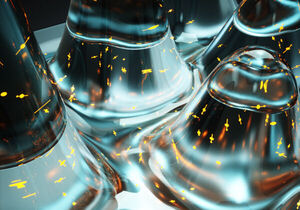
Research Team Unlocks Secret Path to a Quantum Future
"Berkeley Lab-led research key to next-gen quantum computing and technologies In 1998, researchers including Mark Kubinec of UC Berkeley performed one of the first simple quantum computations using individual molecules. They used pulses of radio waves to flip the spins of two nuclei in a molecule, with each spin’s “up” or “down” orientation storing information in the way that a “0” or “1” state stores information in a classical data bit. In those early days of quantum computers, the combined orientation of the two nuclei – that is, the molecule’s quantum state – could only be preserved for brief periods in specially tuned environments. In other words, the system quickly lost its coherence. Control over quantum coherence is the missing step to building scalable quantum computers. Now, researchers are developing new pathways to create and protect quantum coherence." [...]

First results from Perseverance mission show evidence of flash floods on Mars
"Images point the way to understanding ancient climate on the Red Planet New images from the Perseverance mission show evidence of delta and flood deposits in Jezero Crater on Mars, indicating that there were massive flash floods as well as periods of stability on the Red Planet. The deltas are an ideal place to search for signs of ancient life. “These images show large boulders that have been washed down the river. They could have only been moved by powerful flood waters,” said Roger Wiens, principal investigator for SuperCam at Los Alamos National Laboratory. “The location of the boulders also tells us that the lake was not full at the time of the flash floods, indicating fluctuating water levels. This could mean Mars experienced changes in climate over time.” The key images were taken at a distance of nearly 1.4 miles (2.2 km) by the Remote Micro Imager on the SuperCam instrument, which provides crucial information for the mission." [...]
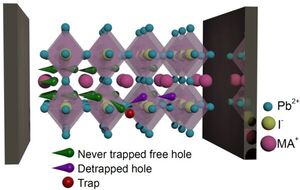
Perovskite solar cells: Defects trap charge carriers - and release them again
"An international team at HZB and Charles University Prague has investigated how charge carriers in so called MAPI-perovskite semiconductors interact with different defects. They show that a large proportion of defects quickly releases trapped charge carriers. These results could help to further improve the properties of perovskite solar cells. Among the most exciting materials for solar cells are the so-called MAPI semiconductors. They consist of organic methylammonium cations and lead iodide octahedra that form a perovskite structure. MAPI based solar cells have achieved efficiencies of 25 % within a few years." [...]

Welcoming composite inks into the fold
"A screen-printing approach to creating foldable circuits could make many functional devices easier and cheaper to mass produce. A method that combines screen-printable composite and metallic inks could make foldable electronics easier and cheaper to manufacture at industrial scales. These devices, developed at KAUST, can be mounted on various supports, including nonplanar surfaces, and could enable many Internet of Things applications. Next-generation technology such as automotive radars for self-driving cars, smart buildings and wearable sensors will depend more heavily on the high-frequency millimeter-wave band, including 5G. To date, large-scale manufacturing approaches to make foldable electronics have focused on developing metallic inks and printing conductive patterns and have overlooked dielectric substrates. There have been a range of barriers to the use of substrates such as paper and some polymer films in foldable electronics." [...]

NIST, Collaborators Develop Sensitive New Way of Detecting Transistor Defects
"Researchers at the National Institute of Standards and Technology (NIST) and collaborators have devised and tested a new, highly sensitive method of detecting and counting defects in transistors — a matter of urgent concern to the semiconductor industry as it develops new materials for next-generation devices. These defects limit transistor and circuit performance and can affect product reliability. A typical transistor is, for most uses, basically a switch. When it’s on, current flows from one side of a semiconductor to the other; switching it off stops the current. Those actions respectively create the binary 1s and 0s of digital information. Transistor performance critically depends on how reliably a designated amount of current will flow." [...]

New Discovery Offers a Glimpse of Our Solar System’s Potential Fate when the Sun Dies
"A team including UMD astronomers found a Jupiter-like planet orbiting a white dwarf star Astronomers have discovered the first confirmed planetary system that offers a glimpse into the fate of our solar system about five billion years into the future. That’s when our sun is expected to exhaust all its nuclear fuel and fade into a white dwarf, or dead star. The newly discovered planetary system consists of a Jupiter-like planet with a similar orbit revolving around a white dwarf star located near the center of our Milky Way galaxy. This discovery provides evidence that planets orbiting far enough from their sun can continue to exist after their sun dies. The study was published on October 13, 2021, in the journal Nature. “It is the first known planet orbiting a white dwarf in a Jupiter-like orbit,” said the study’s co-author David Bennett, a University of Maryland astronomer and researcher at NASA’s Goddard Space Flight Center." [...]
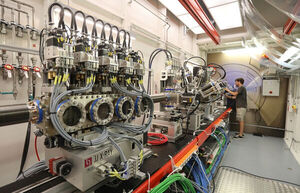
ITMO Researchers Ramp Up X-Ray Laser Research Into Nano- and Biomaterials
"In 2019, a Russian federal program for the development of synchrotron and neutron-focused research was launched. The program will go on until 2027; in that time, new megascience-class projects, such as X-ray lasers, synchrotrons, and neutron generators, are expected to be launched. As part of the program, in 2021 the Russian Ministry of Science and Higher Education announced a contest for research and specialist training. A team of scientists from ITMO University participated in the contest and won with a project on X-ray laser technologies in nano- and biomaterials science. Why we need X-ray lasers An X-ray free-electron laser emits short and highly intensive pulses of light in the X-ray band, focused within a small area. This allows scientists to conduct measurements with high temporal, spatial, and energy resolution." [...]

LEONARDO, the Bipedal Robot, Can Ride a Skateboard and Walk a Slackline
"LEO carves out a new type of locomotion somewhere between walking and flying Researchers at Caltech have built a bipedal robot that combines walking with flying to create a new type of locomotion, making it exceptionally nimble and capable of complex movements. Part walking robot, part flying drone, the newly developed LEONARDO (short for LEgs ONboARD drOne, or LEO for short) can walk a slackline, hop, and even ride a skateboard. Developed by a team at Caltech's Center for Autonomous Systems and Technologies (CAST), LEO is the first robot that uses multi-joint legs and propeller-based thrusters to achieve a fine degree of control over its balance. A paper about the LEO robot was published online on October 6 and was featured on the October 2021 cover of Science Robotics. "We drew inspiration from nature. Think about the way birds are able to flap and hop to navigate telephone lines," says Soon-Jo Chung, corresponding author and Bren Professor of Aerospace and Control and Dynamical Systems." [...]
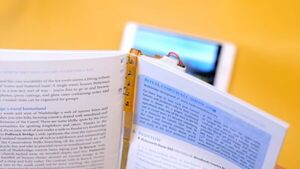
Surrey researchers breathe new life into paper books with the Magic Bookmark
"The University of Surrey has developed a new, cost-effective, ecological solution for augmenting the printed page with rich, up-to-date digital content. The development overcomes one of the most significant advantages e-books have over paper books, helping paper maintain its strong position in its competition with electronic media. Researchers at the University of Surrey’s Advanced Technology Institute and Digital World Research Centre have designed an elegant and intuitive electronic system that allows the readers of a paper book to access related multimedia content by simply placing a bookmark on a page. The Magic Bookmark uses optical contrast sensors to discern a pattern printed next to the book’s spine on each page. Because no electronics are embedded in the paper book, costs are minimised, and end-of-life recycling is enabled. The research, published in the peer-reviewed Advanced Intelligent Systems journal, explores several ways of making the system." [...]

Quantum Phase Transition Detected on a Global Scale Deep Inside the Earth
"Spin transition discovered in the Earth’s mantle; finding will improve understanding the Earth’s interior, and enable better understanding of tectonic events including volcanic eruptions and earthquakes. The interior of the Earth is a mystery, especially at greater depths (> 660 km). Researchers only have seismic tomographic images of this region and, to interpret them, they need to calculate seismic (acoustic) velocities in minerals at high pressures and temperatures. With those calculations, they can create 3D velocity maps and figure out the mineralogy and temperature of the observed regions. When a phase transition occurs in a mineral, such as a crystal structure change under pressure, scientists observe a velocity change, usually a sharp seismic velocity discontinuity. In 2003, scientists observed in a lab a novel type of phase change in minerals--a spin change in iron in ferropericlase, the second most abundant component of the Earth’s lower mantle." [...]
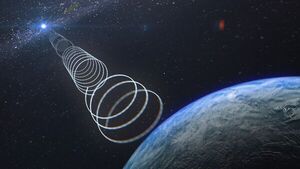
Strange radio waves emerge from direction of the galactic centre
"A signal from deep in the Milky Way is tantalising scientists International student Ziteng Wang detected unusual signals from deep in the heart of the Milky Way using CSIRO's ASKAP radio telescope. Now astronomers are on the search for more evidence of what type object could be emitting them. Astronomers have discovered unusual signals coming from the direction of the Milky Way’s centre. The radio waves fit no currently understood pattern of variable radio source and could suggest a new class of stellar object. “The strangest property of this new signal is that it is has a very high polarisation. This means its light oscillates in only one direction, but that direction rotates with time,” said Ziteng Wang, lead author of the new study and a PhD student in the School of Physics at the University of Sydney." [...]
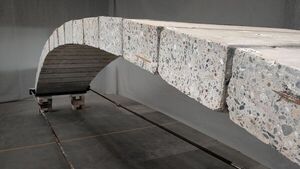
Building out of concrete, but without pouring concrete
"EPFL researchers have built a footbridge prototype using reinforced-concrete blocks from walls of a building being renovated. The blocks were cut into individual pieces on site and assembled into a prestressed arch. This project, which marks the first time concrete has been reused in this way, is part of an initiative to substantially shrink the construction industry’s carbon footprint by adopting a circular economy approach. The footbridge will be inaugurated at a ceremony at the Smart Living Lab in Fribourg on 11 October. “People are hesitant to reuse concrete due to a variety of concerns,” says Corentin Fivet, a tenure-track assistant professor at EPFL and head of the Structural Exploration Lab (SXL) within the Smart Living Lab. “But we wanted to show that those concerns are largely unfounded." [...]
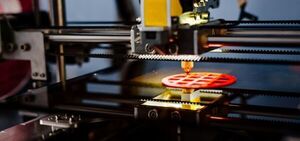
New hybrid 3D printing technique will add a fourth dimension to additive manufacturing
"A new chemical process for additive manufacturing suggests exciting possibilities for 4D printed components – such as properties that change over time. Researchers at Loughborough University have developed a hybrid method called Material Treatment Extrusion Additive Manufacturing (MaTrEx-AM), which uses acetone to toughen targeted layers of 3D printed parts and structures. Varying how much acetone is applied and where it is used allows manufacturers to create items with novel mechanical properties, such controlling how parts deform. The ability to create these time-dependent gives the printing process a 4D aspect. Real-world applications include 4D lattices for helmet padding to avoid impact injuries and for biomedical implants. Dr Andy Gleadall said: “The process adds material layer-by-layer – there are grooves between the layers, a bit like you’d see if you stacked lot of logs sideways on top of one another, all lined up." [...]
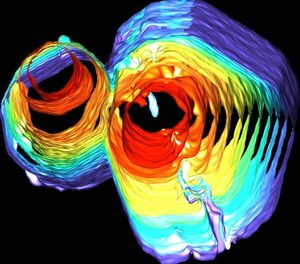
Resurrecting quasicrystals: Findings make an exotic material commercially viable
"Self-healing phenomenon could reduce defects that rendered quasicrystals impractical A class of materials that once looked as if it might revolutionize everything from solar cells to frying pans—but fell out of favor in the early 2000s—could be poised for commercial resurrection, findings from a University of Michigan-led research team suggest. Published in Nature Communications, the study demonstrates a way to make much larger quasicrystals than were possible before, without the defects that plagued past manufacturers and led quasicrystals to be dismissed as an intellectual curiosity. “One reason why industry gave up on quasicrystals is because they’re full of defects,” said Ashwin Shahani, U-M assistant professor of materials science and engineering and chemical engineering and a corresponding author on the paper. “But we’re hoping to bring quasicrystals back into the mainstream. And this work hints that it can be done.” Quasicrystals, which have the ordered structure but not the repeating patterns of ordinary crystals, can be manufactured with a range of alluring properties. They can be ultra-hard or super-slippery." [...]

Engineers 3D-Print Personalized, Wireless Wearables That Never Need a Charge
"The new devices, custom made to fit individuals, could mean massive improvements in the monitoring and treatment of diseases, the testing of new drugs and the ability to track personal health. Wearable sensors to monitor everything from step count to heart rate are nearly ubiquitous. But for scenarios such as measuring the onset of frailty in older adults, promptly diagnosing deadly diseases, testing the efficacy of new drugs or tracking the performance of professional athletes, medical-grade devices are needed. University of Arizona engineers have developed a type of wearable they call a "biosymbiotic device," which has several unprecedented benefits. Not only are the devices custom 3D-printed and based on body scans of wearers, but they can operate continuously using a combination of wireless power transfer and compact energy storage. The team, led by Philipp Gutruf, assistant professor of biomedical engineering and Craig M. Berge Faculty Fellow in the College of Engineering, published its findings today in the journal Science Advances." [...]
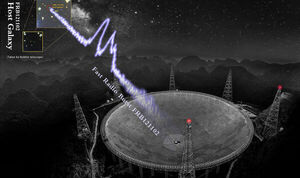
Over A Thousand Cosmic Explosions in 47 days Detected by FAST
"An international research team led by Prof. LI Di and Dr. WANG Pei from National Astronomical Observatories of Chinese Academy of Sciences (NAOC) caught an extreme episode of cosmic explosions from Fast Radio Burst (FRB) 121102, using the Five-hundred-meter Aperture Spherical radio Telescope (FAST). A total of 1,652 independent bursts were detected within 47 days starting Aug. 29, 2019 (UT). It is the largest set of FRB events so far, more than the number reported in all other publications combined. Such a burst set allows for the determination, for the first time, of the characteristic energy and energy distribution of any FRB, thus shedding light on the central engine powering FRBs. These results were published in Nature on Oct. 13, 2021 (US Eastern Time). FRBs were first detected in 2007." [...]

A highly simplified way to predict quantum light-matter interactions
"When light interacts with matter, for example when a laser beam hits a two-dimensional material like graphene, it can substantially change the behavior of the material. Depending on the form of interaction between light and matter, some chemical reactions appear differently, substances turn magnetic or ferroelectric or begin to conduct electricity without any losses. In some particularly thrilling cases, an actual light source may not even be necessary because the mere possibility for light to exist, i.e., its quantum equivalent, the photons, can change the behavior of matter. Theoretical scientists try to describe and predict these fascinating phenomena because they could be crucial in the development of new quantum technologies. However, calculating quantum light-matter interactions not only eats up enormous amounts of time and computing power – it also becomes very cumbersome. Describing the strong interaction between a realistic material with photons easily consumes thousands of Euros." [...]

New Nanostructure could be the key to quantum electronics
"Using a completely new synthesis approach, nanostructures made of aluminium single crystals and the semiconductor germanium are explored at TU Wien for future quantum technologies. A novel electronic component from TU Wien (Vienna) could be an important key to the era of quantum information technology: Using a tailored manufacturing process, pure germanium is bonded with aluminium in a way that atomically sharp interfaces are created. This results in a so-called monolithic metal-semiconductor-metal heterostructure. This structure shows unique effects that are particularly evident at low temperatures. The aluminium becomes superconducting - but not only that, this property is also transferred to the adjacent germanium semiconductor and can be specifically controlled with electric fields. This makes it excellently suited for complex applications in quantum technology, such as processing quantum bits." [...]
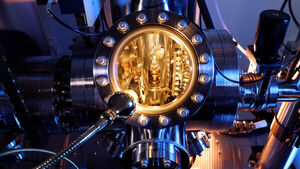
Stress Can Be Good For You: Enhancing Piezoelectric Properties Under Pressure
"Stress enhances the properties of a promising material for future technologies. UNSW researchers find a new exotic state of one of the most promising multiferroic materials, with exciting implications for future technologies using these enhanced properties. Combining a careful balance of thin-film strain, distortion, and thickness, the team has stabilised a new intermediate phase in one of the few known room-temperature multiferroic materials. The theoretical and experimental US-Australian study shows that this new phase has an electromechanical figure of merit over double its usual value, and that we can even transform between this intermediate phase to other phases easily using an electric field. As well as providing a valuable new technique to the toolkit of all international material scientists working with multiferroics and epitaxy, the results finally shed light on how epitaxial techniques can be used to enhance functional response of materials for future application in next -generation devices. STRESS CHANGES EVERYTHING If 2020-21 has taught us anything, it’s that stress changes everything." [...]

TU Delft researchers realize quantum teleportation onto mechanical motion of silicon beams
"Quantum technology typically employs qubits (quantum bits) consisting of, for example, single electrons, photons, or atoms. A group of TU Delft researchers has now demonstrated the ability to teleport an arbitrary qubit state from a single photon onto an optomechanical device – consisting of a mechanical structure comprising billions of atoms. Their breakthrough research, now published in Nature Photonics, enables real-world applications such as quantum internet repeater nodes while also allowing quantum mechanics itself to be studied in new ways. Quantum optomechanics The field of quantum optomechanics uses optical means to control mechanical motion in the quantum regime. The first quantum effects in microscale mechanical devices were demonstrated about ten years ago. Focussed efforts have since resulted in entangled states between optomechanical devices as well as demonstrations of an optomechanical quantum memory." [...]

A Sunny Outlook for Solar
"New research demonstrates great promise of all-inorganic perovskite solar cells for improving the efficiencies of solar cells Hybrid organic-inorganic perovskites have already demonstrated very high photovoltaic efficiencies of greater than 25%. The prevailing wisdom in the field is that the organic (carbon- and hydrogen-containing) molecules in the material are crucial to achieving this impressive performance because they are believed to suppress defect-assisted carrier recombination. New research in the UC Santa Barbara materials department has shown not only that this assumption is incorrect, but also that all-inorganic materials have the potential for outperforming hybrid perovskites. The findings are published in the article “All-inorganic halide perovskites as candidates for efficient solar cells(link is external),” which appears on the cover of the October 20 issue of the journal Cell Reports Physical Science. “To compare the materials, we performed comprehensive simulations of the recombination mechanisms,” explained Xie Zhang, lead researcher on the study. “When light shines on a solar-cell material, the photo-generated carriers generate a current; recombination at defects destroys some of those carriers and hence lowers the efficiency." [...]

Molecular mixing creates super stable glass
"Researchers at Chalmers University of Technology, Sweden, have succeeded in creating a new type of super-stable, durable glass with potential applications ranging from medicines, advanced digital screens, and solar cell technology. The study shows how mixing multiple molecules – up to eight at a time – can result in a material that performs as well as the best currently known glass formers. A glass, also known as an ‘amorphous solid’, is a material that does not have a long-range ordered structure – it does not form a crystal. Crystalline materials on the other hand, are those with a highly ordered and repeating pattern. The fact that a glass does not contain crystals is what makes it useful. The materials that we commonly call ‘glass’ in everyday life are mostly silicon dioxide-based, but glass can be formed from many different materials." [...]
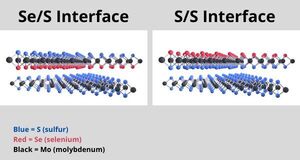
A new twist on 2D materials may lead to improved electronic, optical devices
"“Tuning” the interface and twist angle of layered 2D materials enhances key properties A new generation of electronics and optoelectronics may soon be possible by controlling twist angles in a particular type of bilayer 2D material used in these devices, strengthening the intrinsic electric charge that exists between the two layers, according to researchers from Penn State, Harvard University, Massachusetts Institute of Technology and Rutgers University. The researchers worked with regular transition metal dichalcogenides (TMD) 2D materials and Janus TMDs, a class of 2D materials named after the Roman god of duality, Janus. These bilayer 2D materials have an interaction between layers known as a van der Waals interlayer coupling that leads to a charge transfer, a process important to the functionality of electronic devices. The charge transfer for both sides of conventional TMDs is the same due to each side having the same type of atoms. In the case of Janus TMD materials, the atoms on each side of the material are different types, leading to varied charge transfer when each side is in contact with other 2D materials. “In our study, the two types of atoms on each side of the Janus TMD material were sulfur and selenium,” said Shengxi Huang, assistant professor of electrical engineering and biomedical engineering at Penn State and co-author of the study recently published in ACS Nano." [...]
Projetos Maker
Diversos Projetos interessantes.

Old School Minitel Laptop
"Hi everyone, On this Instructables, I will explain how I manage to convert an old Minitel to a "brand new" laptop ideal for taking notes in college ^^. This project was one of the first I made, so the wiring is not perfect and some photos are missing, but the overall idea of the project is here. Now you can do it easily thanks to the wiring diagram and all the files availables. The idea : Converting an old Minitel bought at a garage sale into a battery-powered laptop. The Minitel screen has been replaced by a 10.4 inch LCD screen. An Arduino board is used to simulate a keyboard for the Raspberry Pi which is the brain of the computer." [...]

Rotary Dial Arduino Input
"This project was intended to serve as a proof of concept for using a rotary phones dial as an interface between a user and the Arduino microcontroller. However, this experiment quickly turned into an opportunity to learn all about the Atmega328Ps various timer and interrupt capabilities and how to manually set registers within the Arduino IDE in order to utilize them and handle IO operations more efficiently. This section includes a brief video demonstration of the rotary dial's use as an input to a microcontroller. While disassembling a few legacy phones, I was excited to learn that their dials are completely self-contained devices that operates as mechanical switch. When the user draws the dial back to a specific number the switch will periodically open that number of times, with a specific timing that is dictated by the rotary dial’s inner clockwork. In order to test the possibility of using the device to act as a sort of keypad, the circuit depicted in the top diagram was constructed." [...]
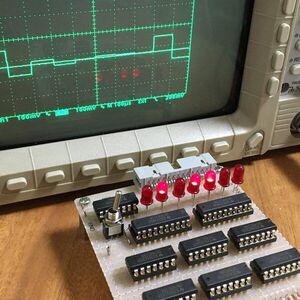
Homemade Successive Approximation Register ADC
"This is a homemade 7-bit SAR ADC using discrete components for principle study. The following is an introduction to a Successive Approximation Register Analog to Digital Converter (SAR ADC) that I made myself for principle study, and observing the conversion behavior inside the SAR ADC allows you to experience the operation of both analog and digital circuits. In 1979, I made my own 8-bit digital sampling unit for analog oscilloscopes, and this is a recent reproduction of that SAR ADC in 7-bit format. The concepts are as follows. (1) The SAR will consist of as few as general standard logic ICs. (2) A self-running mode will be provided so that the behavior of the ADC can be observed with this board alone." [...]

How to Make a News Station Inside a Retro Mini TV
"One of history's greatest inventions is the television however, with each passing decade the television loses some of its original flare. I want to bring some of that classic charm back to life in this build. Last year I built my first version of this retro television. It was powered by an ESP32 and it displayed local weather data which worked really well. Although it was fully 3D-printed so it lacked that true retro aesthetic. To fix that, I wanted to try and build the housing for the electronics out of wood which I have never used in a project before but it turned out pretty well." [...]
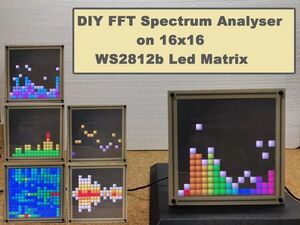
DIY Simple FFT Spectrum Analyzer,VU Meter and Waterfall Analyzer on 16x16 Led Matrix
"This time I will show you how to make a visually beautiful spectrum analyzer that can also function as an Audio VU Meter and Waterfall Analyzer. The device is made on 16x16 LED matrix with WS2812 chip on diodes which costs about 12 USD. When we use Line input, the incoming stereo signal is first converted to mono using two 10K resistors, then through a 100nF capacitor to block DC. The signal is then biased by two 100k resistors to 3.3V / 2 = 1.65V to be read by the ADC. Using the Microfon board is much simpler than the line-in method, but you will be limited to the frequencies that you can detect by the sensitivity of the microphone. The matrix is controlled from a single button." [...]

Arduino OLED Oscilloscope
"Low frequency oscilloscope using OLED display OLED low frequency oscilloscope, bandwidth is DC to 1000Hz. Max sampling rate is 16000 samples per second. An oscilloscope with these specifications has limited use, but it is a good exercise in using OLED display. The trace is 60 pixels that are placed on Y axis depending on the analogue signal to the Arduino input. Input voltage is 0-5V max. Switch is for input frequency below 100Hz." [...]
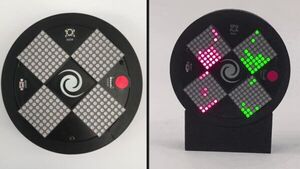
LED Matrix Dual Hourglass
"An hourglass sand simulator built with ATmega328 (Arduino), MPU-6050 accelerometer, and four 8x8 red/green LED matrix displays. " [...]

Kinetic Soul: Experience Dance through Touch
"A platform which enables the visually impaired to experience dance via kinetic feedback. Dance is an art we often look at to understand and connect with one another. To the visually impaired, however, connecting with someone’s dance is hard without sight. How might we redesign the way we experience a dance? Kinetic Soul is a platform which enables the visually impaired to experience dance via kinetic feedback. Using a computer vision based system, a dancer’s movement is tracked, translated and conveyed through kinetic pins felt by the palms." [...]
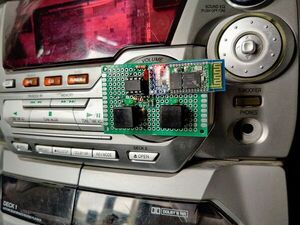
Bluetooth Volume Control For An Old Stereo With Buttons!
"How about getting rid of that broken volume knob on your stereo and replacing it with some buttons, LEDs and Bluetooth? What is it all about? It's a rather detailed (hopefully) description on how to replace a stereo system's volume knob which uses a rotary encoder with a custom board with buttons and Bluetooth connectivity. Introduction For starters, an important note: this project is written with the Panasonic SA-AK45 stereo system in mind (because that's what I worked with), but will work for any other sound system using a rotary encoder for volume control (apart from the system disassembly instructions of course). Note that encoders used by other systems might (but don't have to) have a slightly different signal profile (this can be handled easily by small adjustments in the software - more on that in the appropriate step). With that out of the way, let's get to the proper intro." [...]

DIY Arduino Superheterodyne Receiver
"In this project, we will upgrade a traditional shortwave superheterodyne receiver with an Arduino base tuner. This tuner is capable of receiving shortwave broadcasts on 41m band and above. This modularized receiver consists of a transistor base mixer, I.F amplifier, Si5351 clock generator, and an Arduino Uno board. Supplies 455kHz IF Amplifier - C1 - 100µF/16V Electrolytic Capacitor - C2 - 10µF/16V Electrolytic Capacitor - C3, C4, C5 - 0.047µF - R1 - 330KΩ - R2, R4 - 1KΩ - R3 - 220KΩ - R5 - 330Ω - T1 - 50A01 / 42IF101 / 455kHz Yellow I.F Transformer - T2 - 50A02 / 42IF102 / 455kHz White I.F Transformer - T3 - 50A03 / 42IF103 / 455kHz Black I.F Transformer - Q1, Q2 - 2SC724, 2SC930, BF494, BC337, or 2SC829 - J1, J2, J3 - 3.5mm Screw Terminal RF Mixer, Filter and Detector Stage - C1, C3 - 0.001µF - C2 - 330pF - C4, C7 - 0.01µF - C5 - 10pF - C6 - 0.02µF - C8 - 100pF - R1 - 100KΩ - R2 - 22KΩ - R3 - 220Ω - R4 - 1KΩ - R5 - 330Ω - D1 - 1N34 or OA90 - Q1 - 2SC724, 2SC930, BF494, BC337, or 2SC829 - J1, J3, J5 - 3.5mm Screw Terminal - J2, J4 - 2.54mm Pin Header - L1, L2 - 1µH Inductor Receiver - Arduino Uno Rev. 3 - Si5351 Clock Generator Module" [...]
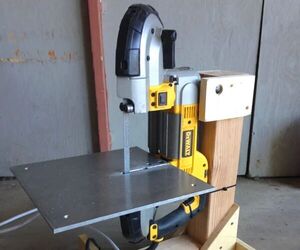
Bandsaw Stand From Scrap Lumber
"I have a portable bandsaw that I absolutely love- it's one of my favorite and most useful tools. Cutting small pieces of metal with any degree of precision can be difficult however. What I needed was a stand to turn it into a benchtop saw. This is a super simple low cost stand that is very easy to make and can be built in an afternoon. Let's get started! Tools needed - Portable bandsaw- mine is the DeWalt DWM 120 model - Drill - Various size drill bits - 3/4" forstner or spade bit Materials - 2" wood screws - Wood glue - 2ea 1" x 4" x 14" long wood board (I used pine) - 2ea 1" x 4" x 5 1/2" long wood board - 1ea 4" x 4" x 20 1/2" long post - 1ea 4" x 4" x 9 1/2" long post - 2ea 8" x 8" x 3/4" plywood triangle - 1ea 12" x 12" x 1/4" thick Aluminum plate- I used a piece of salvaged Aluminum I found but you could also use a thicker piece of wood." [...]
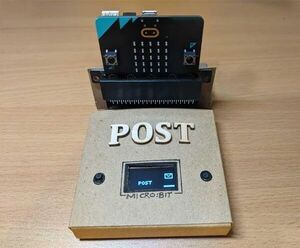
Micro:bit OLED Game
"There was a time when every kid wanted a Nintendo Game & Watch handheld electronic game. This combined a very simple LCD screen with a very simple game mechanic. An early example was the Fire game, where you moved the firemens safety net left or right to bounce residents from a burning building on the left into a waiting ambulance on the right. Let's add an OLED screen to the BBC Micro:bit to create an homage to these games. We'll need to use a breakout board and a breadboard to connect the Micro:bit to a 128x64 OLED display, and we'll need to write the game in Python. Well call the game Post, and bounce letters from left to right using a paddle." [...]
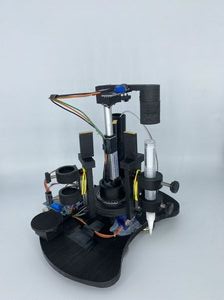
DUCO
"DUCO is an open-source, tool switchable robotic system capable of drawing multi-layer circuits on versatile vertical surface. Assembling parts are highly accessible and low cost. It's inspired by Sandy Noble's work Polargraph DUCO is developed for large scale circuits fabrication, but maintaining considerable local precision and resolution. It has default optimal configuration for several drawing substrates - wall paper, glass, wood and etc, also supporting other substrate exploitation. While linear actuator, laser cutter are well explored in this project, DUCO still have the extensible ability to welcomes all other tools like vinyl cutter and dispenser. High-level ability - Two-stepper locomotion system with well set Cartesian-to-polar solution - Meter size canvas - Up to 3 tools mounting platform." [...]

Scan View-Master Reels to Digital Video. Its the View-ReMaster!
"For this project, I made a View-Master Reel scanner. I call it the View-Remaster. In short, this will scan in 3D View-Master reels and create a side-by-side (SBS) video that I can watch on YouTube. So I have been scanning in a reel every week on my Reel3D YouTube channel. Cool name right?? The Reel3D channel is here, take a look at the scans I have done so far." [...]

Raspberry Pi 400 as a USB HID Keyboard
"Hook your Pi 400 up to your PC somehow, using a USB Type-C cable into the power port. Anker make good ones- I used a 3m white one for my tests. " [...]

Tulipa x RGB Edition
"Made a 3D Printed Attiny85 Powered RGB TULIP as a Decoration item for my living room. Original idea was to grow some actual tulips but I have no clue how to do that, all I know is to make RGB Related stuff so I made my version of these Darwin Hybrid Tulips with 3D Printed parts and custom PCBs. The brain of this project is an Attiny85 and it's controlling 49 WS2812B LEDs each soldered on their Breakout board which I made. My goal here is to make a nice wall decorative light that looks like a tulip, I made this shape by molding a tulip doodle I found online. In this post, I'm gonna show you guys how I made this Flower shaped lamp in few easy steps. Let's get started!" [...]

Make Your Own Speakers Out of Mycelium
"This is a how-to guide on how to create your own speakers from mycelium using 3D printed molds. Deviations of this project are encouraged! This guide will give you a step-by-step process on how to create your own mycelium speakers. Skills needed for this project include soldering, 3D printing, and mycelium growing. This project takes roughly 10 days to complete given the amount of time needed for the mycelium to grow. This project is graded at moderate difficulty." [...]

Folding Clock
"An interesting 3D printed clock that folds out flat or back on top of itself. Recently I build a Cube clock that showed the time in the same orientation no matter what orientation the clock itself was in. This was inspired by the Lexon Flip Travel Reversible LCD Alarm Clock. One of the other thoughts that I had at the time was a folding clock. This clock was designed based on components that I already had on hand; mainly the two 0.8in 4-Digit 7-Segment clock displays. Since the clock is in two parts, it made more sense to use two 4-Digit, 7-Segment display drivers (TM1650) rather than a single MAX7219 8-Digit 7-Segment display driver." [...]
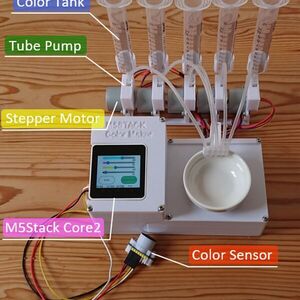
M5Stack Color Maker
"With this device, you can copy the color of an object or create a new color with your imagination. Features M5Stack Color Maker has the following three functions. 1.Scan for color information This device has an I2C-connected color sensor that can pick the color of an object. 2.Edit color information We are using a development board called M5Stack Core2 for the device UI. This board has a touch-sensitive LCD screen, and the color can be adjusted by controlling the slider. In addition to editing the scanned color information, it is also possible to create new color 3.Colorize paint based on color information The device is equipped with a tank of water and four colors of paint: cyan, magenta, yellow, and black." [...]
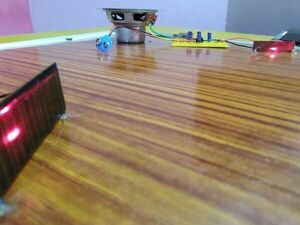
Wireless Audio Transmission using Li-Fi
"Wireless Audio Transmission using Li-Fi using Red Pitaya Wireless Audio Transmission using Li-Fi Introduction to Li-Fi Li-Fi (also written as LiFi) acronym for Light Fidelity is a wireless communication technology that utilizes light to transmit data and position between devices. It is capable of transmitting data at high speeds over visible light, ultraviolet, and infrared spectrums. In its present state, only LED lamps can be used for the transmission of data in visible light. In terms of its end-use, the technology is similar to Wi-Fi — the key technical difference being that Wi-Fi uses radio frequency to induce a voltage in an antenna to transmit data, whereas Li-Fi uses the modulation of light intensity to transmit data. Li-Fi can theoretically transmit at speeds of up to 100 Gbit/s. Li-Fi's ability to safely function in areas otherwise susceptible to electromagnetic interference (e.g." [...]

Wireless Gas Sensor Network Node
"Hi, in this instructable we'll make wireless sensor network modules (transmitter & receiver) and we'll be monitoring 7 different MQ series gas sensors' output (MQ-2, MQ-3, MQ-5, MQ-6, MQ-7, MQ-8 and MQ-135) from our PC. We'll be using Arduino Nano and nRF24L01 modules on both the transmitter and the receiver modules. Supplies: Arduino Nano (or other model) *2 , nRF24L01 tranceiver module *2, 100microFarad capacitor *2, jumper cables, 5V power supply (2 usb output power bank is used in this project), circuit board (optional, all can be done on breadboards as well), MQ series gas sensors. " [...]
E-Ink Tide and Weather Tracker
"Tracking the tides and weather at your favorite beach. My parents recently got a place on the water and have been obsessed with looking up the tides everyday so I decided to build them a custom TideTracker. The idea is to present the predicted high and low times for the day and a plot showing the tide over the last 24 hours. In addition to that I added some basic weather data to give them info at a glance. This project uses a Raspberry Pi for the brains and an E-Ink display for the information. When researching the project initially I found a similar project by Luke Haas that I used to test the display's functionality before writing my own program, check that project out here." [...]

Easy adjustable minutes AC timer
"Ever let your soldering iron or gluegun burning all night by accident? This is the solution! Did you ever forget to turn off.... your soldering iron or glue gun? I did and it felt just stupid. What if there was a simple device that does it for you? Wouldn’t it be too much work to set it properly?" [...]

3D-printable double helical gear pump watertight
"Fully 3D-printable hydraulics for all your robotics projects Recently saw a video of Boston Dynamics it's Atlas robot doing all kind of awesome stuff and learned that the robots were fully hydraulic. I was wondering if it would be possible to build a fully 3D-printable hydraulic system that's watertight and can be used for robotics. This double helical gear pump is the first component of the fully 3D-printable hydraulic system. As mentioned above i thought it would be nice to test if it would be possible to 3D-print watertight hydraulic parts. Gears The gears used inside the pump are double helical gears, also called herringbone gears. I chose to go for this type because they produce less noise compared to regular spur gears." [...]
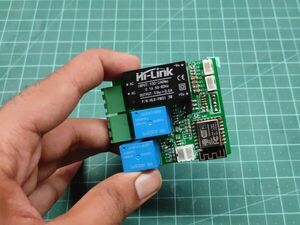
How to make a Perfect Home Automation System
"For a Perfect Home Automation, I selected these points - Compact - IoT Enabled - Works without internet - Features - Easy to Install - Long Life For making a system like this I break this operation into 3 parts - Hardware Phase - Software Phase - Installation Phase" [...]
Secção Videos
Videos interessantes.
That's all Folks!



